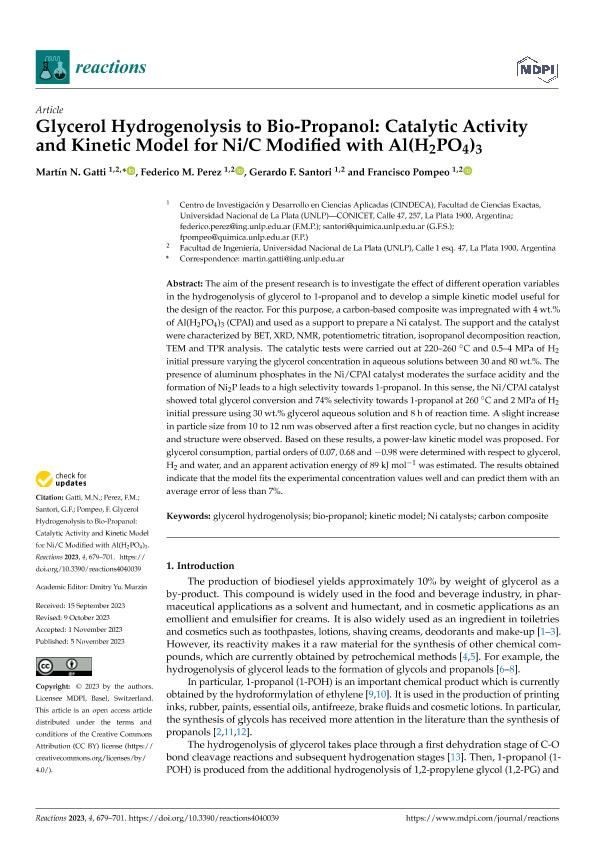Artículo
Glycerol hydrogenolysis to bio-propanol: Catalytic activity and kinetic model for Ni/C modified with Al(H2PO4)3
Fecha de publicación:
11/2023
Editorial:
MDPI
Revista:
Reactions
ISSN:
2624-781X
Idioma:
Inglés
Tipo de recurso:
Artículo publicado
Clasificación temática:
Resumen
The aim of the present research is to investigate the effect of different operation variables in the hydrogenolysis of glycerol to 1-propanol and to develop a simple kinetic model useful for the design of the reactor. For this purpose, a carbon-based composite was impregnated with 4 wt.% of Al(H2PO4)3 (CPAl) and used as a support to prepare a Ni catalyst. The support and the catalyst were characterized by BET, XRD, NMR, potentiometric titration, isopropanol decomposition reaction, TEM and TPR analysis. The catalytic tests were carried out at 220-260 °C and 0.5-4 MPa of H2 initial pressure varying the glycerol concentration in aqueous solutions between 30-80 wt.%. The presence of aluminum phosphates in the Ni/CPAl catalyst moderates the surface acidity and the formation of Ni2P leads to a high selectivity towards 1-propanol. In this sense, the Ni/CPAl catalyst showed total glycerol conversion and 74% selectivity towards 1-propanol at 260 °C and 2 MPa of H2 initial pressure using 30 wt.% glycerol aqueous solution and 8 h of reaction time. A slight increase in particle size from 10 to 12 nm was observed after a first reaction cycle, but no changes in acidity and structure were observed. Based on these results, a power-law kinetic model was proposed. For glycerol consumption, partial orders of 0.07, 0.68 and -0.98 were determined with respect to glycerol, H2 and water, and an apparent activation energy of 89 kJ mol-1 was estimated. The results obtained indicate that the model fits the experimental concentration values well and can predict them with an average error of less than 7%.
Palabras clave:
glycerol hydrogenolysis
,
kinetic model
,
bio-propanol
,
Ni catalysts
Archivos asociados
Licencia
Identificadores
Colecciones
Articulos(CINDECA)
Articulos de CENTRO DE INV EN CS.APLICADAS "DR.JORGE J.RONCO"
Articulos de CENTRO DE INV EN CS.APLICADAS "DR.JORGE J.RONCO"
Citación
Gatti, Martin Nicolas; Perez, Federico Martín; Santori, Gerardo Fabian; Pompeo, Francisco; Glycerol hydrogenolysis to bio-propanol: Catalytic activity and kinetic model for Ni/C modified with Al(H2PO4)3; MDPI; Reactions; 4; 4; 11-2023; 679-701
Compartir
Altmétricas




